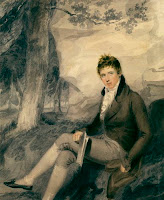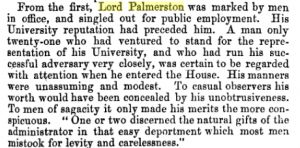Henry John Temple (1784-1865), 3rd Viscount Palmerston was best known for his impressive political career. Having served twice as Prime Minister, and as Foreign Secretary during some of the most brutal conflicts during the Regency era, he began his political career as a Tory and ended as a Liberal.
Beyond his political success, he was also a Regency hottie who maintained a scandalous affaire de coeur with Lady Patroness Emily Cowper until he married her in 1839 as soon as she was out of mourning. It was well known that Palmerston had affairs with Lady Jersey and Princess Dorothy de Lieven (so apparently he favored the Lady Patronesses!) before he began his affair with Lady Cowper in 1810. According to VictorianaWeb, Lady Cowper’s brother, Lord Melbourne, said that his sister was a ‘remarkable woman, a devoted mother, and excellent wife — but not chaste’.
Despite the affair with Emily, Palmerston made proposals of marriage to Lady Georgiana Fane, the younger sister of Lady Jersey: his suit was rejected on all three occasions.
Palmerston was a noted politician even from his days at Cambridge. A biography in 1865 characterized him as a laid back fellow with a natural gift for speaking articulately on any number of subjects. It was this talent that positioned him as an ideal choice for the post of Foreign Secretary.
Beyond his skill within political circles, Palmerston was also a favorite among the Haute Ton. His 1865 biography says:
“WHILE Lord Palmerston had been gradually and firmly securing for himself a place, if not in the foremost, at least in the second rank of statesmen, he had been acquiring laurels in quite another field. England is governed for the most part by its aristocracy. They do not now constitute our only legislators, but they had a much larger share of parliamentary power in Palmerston’s earlier than in his latter days; and they had an almost monopoly of the administration…it is at once obvious how absolutely necessary it was for any politician, who wished to secure his foothold on the ladder of place, to stand well with what is called “society” for want of a better term, as well as with the professional class of leading politicians. It was essential to be a favourite in the drawing-rooms of the leaders of fashion, as well as a power in the House and an authority in the bureau. Whether by his natural qualities or from set intention, Palmerston had perfectly succeeded in making himself a favourite in “society.” And we of the present day have little idea how impregnable and select “society” was in 1814. This fact sufficiently appears from the circumstance that at the date of which we speak, out of the whole of the officers of the brigade of Guards, numbering some three hundred gentlemen, nearly all of them being men of family, fortune, and fashion, only six had the entree to Almack’s, which was then in its glory.
Palmerston had personal qualities which peculiarly fitted him to shine and communicate pleasure in the inner circles of fashion. He had a fine figure, and a face, if not absolutely handsome, at least considerably above the average of male beauty. His rosy and somewhat chubby face, and his profuse curly locks, in connection with his everlasting, half-humorous, half-wicked smile, procured him the sobriquet of “Cupid.”
Palmerston came out when “dandyism” was at its height—a thing to which the dandyism of our own days, as transcribed and stereotyped for posterity by such caricaturists as John Leech, bears only the faintest likeness. Dandyism fifty years ago was an elaborate art—not the dawdling, dolce far niente, “Dundreary” affectation of to-day. Dandyism during the Regency was an art—an art, too, which absorbed the services of many attendant and ancillary arts—tailorism, boot-manufacturing, perfumery, snuff-taking, and the art of wielding a cane. It had a certain curious spice of democracy. It was by no means men of the first families, or even the best fortunes, who were leaders among the dandies. The Prince himself, with his magnificent person and bewitching manners—and with, what was even more important then, his hundreds of snuff-boxes, wigs, and faultless inexpressibles—although it was his highest ambition to be the premier dandy, was completely eclipsed by some of the lowliest of his subjects in his realm of fashion.
Brummel, who by the common consent of many of the women and all the men, bore undisputed sway, was of low origin and without any source of income. D’Orsay, although of good family, was an exile, and almost as poor as Brummel. Alvanley was but a parvenu member of the peerage. It was necessary towards social success that a man should be something of a dandy.
And Palmerston, who all through life has proved himself very willing to obey the apostolic injunction – to be .”all things to all men,” conformed to the prevailing mode. ‘His fine person, his perfect knowledge of the chief modern languages of civilized states, his gay, half-polite, halftantalizing, but wholly amusing insouciance made him a favourite with the fair sex. He confirmed his successesin the House by securing the admiration of the female members of the families of his colleagues and opponents. He was one of the lions of Almack’s. Captain Gronow writes, under date of the very year at which we have arrived in our narrative:—” In 1814 the dances at Almack’s were Scotch reels and the old English country dince; and the orchestra, being from Edinburgh, was conducted by the then celebrated Neil Gow. It was not until 1815 that Lady Jersey introduced from Paris the favourite quadrille which has so long remained popular. The ‘Mazy Waltz’ was also brought to us about this time; but there were comparatively few who first ventured to whirl round the salons of Almack’s; in course of time, however, Lord Palmerston might have been seen describing an infinite number of circles with Madame de Lieven.”…Who knows but that Palmerston may have practised waltzing for diplomatic reasons; and that the handsome couple of waltzers may have been whispering politics while the astonished assembled fashion was admiring their gyrations.”
It is curious that the same page of Captain Gronow’s reminiscences, from which the foregoing extract is made, contains a reference to the lady who a quarter of a century afterwards was to become Lord Palmerston’s wife. After enumerating the then lady patronesses, and enlarging on their several charms, the Captain adds,— “The most popular amongst these grandes dames was unquestionably Lady Cowper, now Lady Palmerston.”
Palmerston, according to these characterizations and the many biography since, was undoubtedly a Regency heartthrob. His manners were the very picture of the Regency Buck, and his political machinations symbolized a climate of intrigue, strategy and Imperialism.
He was also rakish in his conquests, undoubtedly reforming with his marriage to long standing mistress Emily Cowper.
A fascinating Regency gentleman, Lord Palmerston died in office near his 81st birthday.











